Development History
The context is very specific, the "troubles" in Northern Ireland, which started even before the major events of 1917 and went on with a peak in 1975-85. Many armoured vehicles already had been used, but it's in the 1960-70s that tailored ones started to appear, like the Humber Pig. One of the softskin vehicles that was all-time favorites of the Royal Ulster Constabulary (RUC) was the Land Rover. It was by far the most common vehicle of the corps. Originally the latter was created under section 60 of the Government of Ireland Act 1920. It was an odd corps, both assuming standard police law enforcement service while fight a considerable armed or unarmed opposition, so all members received military trained and were armed like an in,fantry corps, but highly mobile for patrols.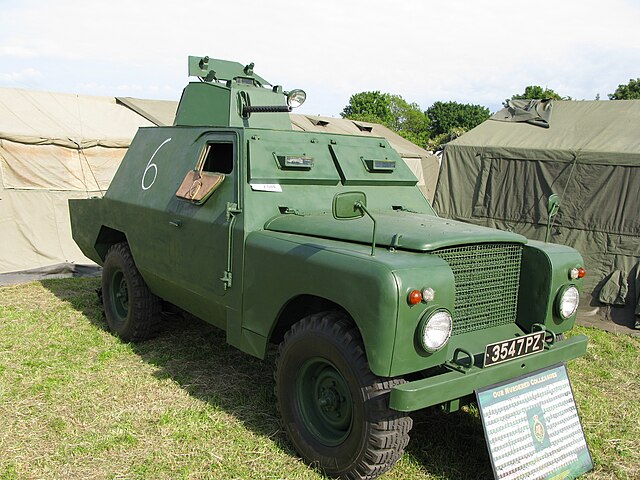
Shorland Mark I
The RUC was indeed during the twenties highly mobile and 3,000-strong. It was reinforced by the "Ulster Special Constabulary" volunteer corps with part-time auxiliary policemen. By its height it represented 8,500 regular police officers plus a 5,000 full-time/part-time reserve, largesi in the whole of UK after the Metropolitan Police of London. Until then, the "Pig" was used by the Army as well, but by September 1972-July 1973 at high political tensions with IRA actions they certainly were the backbone of the Royal Ulster Constabulary. But they were seen as APCs, consumed a lot, and were in limited numbers as 1700 were delivered. The chassis proved popular still, and generated a number of variants, including the Humber Hornet Malkara. However these were heavy vehicles, they had issues and were even considered in some cases too precious to be deployed when an expedient vehicle could do the same job.
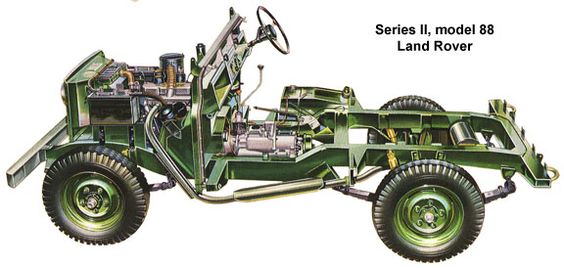
Land Rover Serie II chassis
Thus germinated the idea of armouring Land Rovers in local workshops for an extra supply, quick and easy conversion. Thus was born in concept of the "Shorland" as an armoured patrol car designed specifically by Donald Frederick Butler working, not for the technical staff of the RUC, or the Land Rover park, but Short Brothers and Harland of Belfast. The Short Brothers plc was founded as an aerospace company (Short was a famous airmaker) based on the original London-based 1908 company. Its HQ was in Belfast. The company becamme government owned and produced missiles for the British Armed Forces, almthough mostly busy with aircraft components. It was perfectly able to produce and armoured body for a Land Rover.
The first design meeting took place in November 1961. A first prototype was tested as Short, then a second in 1963, and a third and final prototype completed in 1964, approved, and the first RUC Shorlands were delivered in 1966. The design evolved in time, and they were initially based on the Series IIA Land Rover for standardization. The name "Shorland" was just thee combination of Shorts and Harland. The Mark 1 Shorland first batch of ten production vehicles were made in in November 1965, tested, and sent to the Ministry of Home Affairs in May 1966. It seems they were painted in Battleship grey, a standard of the RUC and a common paint in Belfast due to its past of Naval yard. However the next batches and Mark IIs arrived in a relatively clear emerald green. Later, more standard military military standard paints were applied, even camouflages. All new Mark IIs were in olive drab.
Evolution and succession
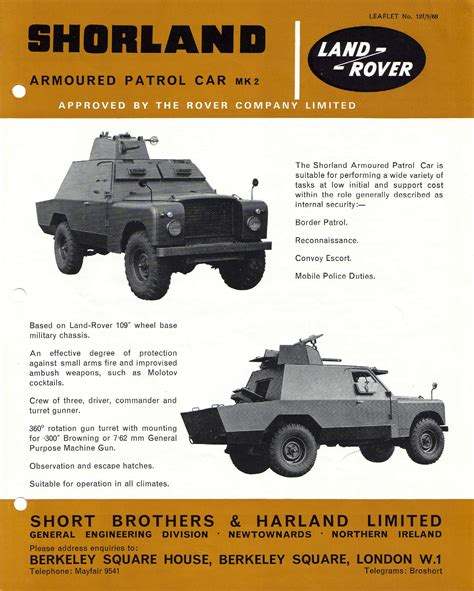
In 1970, the produced batches were reallocated to the Ulster Defence Regiment but eventually the RUC replaced the Shorland and its standard turret, same as for the Daimler ferret and other vehicles, with a simpler armoured Land Rover, more conventional and cheaper to make. However in the late 1980s the park started to show its limits and in the end, the RUC opted for the Land Rover Tangi as successor, designed by the Royal Ulster Constabulary's own vehicle engineering team. It became by far the most common armoured Land Rover. Still, Shorts and Harland went on and further developed the original Shorland.
The first had a crew of three, the last were an armoured personnel vehicle, with six troops at the rear and the latter found use in the Northern Ireland streets as late as 1998. The story did not ended there, as the company in 1996 sold the complete design to British Aerospace Australia, which continued production. It was also largely adopted worlwide and exported, and used in the coldwar abroard, like with the RAF Police in Germany (BAOR) to secure "Special Weapons" (Nuclear) sites and escort transport trucks until the BAOR was disbanded in the 1990s.
About the base:
The Land Rover serie II was produced from 1958-1961 with a 88 in (hence the "model 88") or 2.24 m long or 109 inches (2.77 m) wheelbase, hence the 'SWB' and 'LWB'. It came with its trademark 'barrel side' waistline for wider tracks, reworked truck cab with curved side windows, rounded roof. It was powered by a new 2.25-litre petrol engine rated for 72 hp (54 kW), the great standard until the mid-1980s. The Serie IIA was produced from 1961 and 1971 and only had cosmetic changes, notably a soft-top and a new 2.25-litre diesel. From 1967, a 2.6-litre inline 6-cylinder petrol engine was the LWB Serie IIA far more powerful, notably having servo-assisted brakes. This became the sturdiest, most classic Land Rover with a production of 600,000 vehicles, 70% exported, including on the military market.Design
The vehicle chosen was the IIa LWB (Long wheelbase 109 inches or 2.77m. The chassis was considerably reinforced to support not only the weight of the turret borrowed to the Daimler Ferret Mark 2, but it also had an updated, more robust suspension also to deal with the extra weight. Other than that and the armour itself, this still the "stock" vehicle, upgrade by various engines, more powerful to no lost agility. In total the vehicle was declined into five Marks, the latter having a new technical base entirely (see below) better protection and six sub-versions, including the APC.Protection design
Protection was partial, concentrated on the central cab, and the first experimental armoured body was tested on the Series II LWB Land Rover (registered 4471 AZ) with flat side armour a turret based on the one carried by the Ferret scout car was adopted, but different. Communication between the RUC and Rover conducted to have a sloped armour, on the upper body. This second prototype had a flatter boot section used as storage compartment with a spare wheel, and another sometimes installed above. There was a bulkhead also to separate the fuel tank from the small crew compartment. Approved as the Mark I production, armour thickness was originally of 7.25 mm, Brinnel Hardness 363, but it was increased to 8.25 mm on the Mark 3. There was some confusion in sources, some citing the upgrade on the Mark 2. There was no separation between the driving compartment and fighting one behind.The design was partial, with the forward section of the vehicle virtually untapped, and a lightly sloped main fighting/driving compartment, typically with a driver, co-driver seated at the front and seeing through two armoured shutters dotted with sight blocks of armoured glass. The two side doors were blind however. On the Mark I, II there was however a small window with its armoured shutter usually folded down. There was also a small access hatch with vision block at the back of the rear plate. The ferret-like turret had the same one piece hatch, opening forward.
Mobility
The Mark I had a 4-cylinder petrol engine rated for 67 hhp. The Mark 2 had for its most significant change a better compression ratio brought to 77 bhp at 4100 rpm, with more torque to regain the vehicle some agility. The Mark III was delivered with a 2.6 litre 6-cylinder. And on the Mark IV it was a V8. On the Mark V the same was used, but pushed, and diesels were also adopted, which became standard for all late versions.Performances were not impressive at first, c60 kph at best on road, 40 or less off-road. Range c200 km. It could ford 50 cm, climb a step of 23 cm, and had a turning circle radius of 5 to 6.6 meters. On the Mark IV, the Rover petrol 91 hp (68 kW) allowed to reach 88 km/h (55 mph) for a 260–510 km (160–320 mi) range. On the late Mark V it was 630 km and 120 kph top speed, twice as much as the Mark 1.
As for distinction between types, the Mark I, II, III had the same rounded forward section of the original Land Rover IIa. They could be distinguished externally by Headlights details, as they were moved to the wings even for the early Mark 3. Then they were placed in a manufactured recess for later Mark IV. The Mark IV not only had a larger engine but also a completely different front shape, far more angular. With the larger engine came an equally larger radiator grill and modified headlights, and recesses. On the Mark V they are based on the series 110 Land Rover with a more modern style and new wing armour.
Radio communication when possible, used a A41 radio with whip aerial via the open turret hatch, not the best solution. Communication between the commander and driver required an intercom integrated with radio sets. The A41 was short range, to report to base, fitted behind the drivers seat. It had a too short and fragile microphone and settings frequently "jumped". Later the Pye ‘Bantam’ walkie-talkie was adopted, and then a fixed VHF whip aerial was rear right side mounted, solving issues of unstability of communication.
Armament
It varied in time, between a cal.03 Browning, or a GMPG. Some sub-variants even were equipped with ATGMs (see later). The turret mounted it on the right side. There was a periscope ion top of the turret roof, and a projector at the left side.Variants
Shorland Mark 1 (1965)
Base version, 1965: 10 preserie, then 90 production vehicles, 67 bhp (50 kW) engine. No smoke dischargers nor extractor fan, single fuel tank. Often had an ‘angle iron’ strut welded to the turret to cut/deflect any strung wire across the road. One tested the Water cannon Mk1, with trailer.Shorland Mark 2 (1968)
Slightly advanced versions, 50 made with the 77 bhp (57 kW) engine. Possible armour upgrade and optional 6-cylinder 2,625 cc rated for 84 bhp. Modified optional extractor fan housed in the armored cowl on the escape hatch, to be used in the middle east, in sand livery. Also optional second fuel tank (320 miles), and double supports for the turret rear flap, Pye type VHF whip antenna on the tail.Shorland Mark 3 (1972)
Main production versions, early and late types differed. c500+ manufactured, by far the most common. 91 bhp (68 kW) engine or 95 bhp at 4,500 rpm (compression ratiof 7.8:1) and allegedly even thicker armour. Late production had two sets of three smoke dischargers mounted forward of the turret. Sub-variants comprised the Anti-Hijack Shorland (more to come), Blowpipe Shorland (firing the Vigilant ATGM). Both stayed prototypes.Shorland Mark 4 (1980)
Evolved variant, c250 made. 3.5 litre Rover V8 petrol engine and improved armour, extended on the wings and perhaps up to 9mm.Shorland Series 5
c300 made, based on the Defender 110 chassis, with the same 3.5 litre Rover V8, but also a new 2.5 litre Rover Tdi Turbo diesel engine. They had a Welded armour fully enclosed body.- S5: prototype
- S51: Armored Patrol Car
- S52: Armored Patrol Car
- S53: Air Defgence vehicle*
- S54: Anti-hijacking vehicle
- S55: Armoured Personal Carrier
**The S54 had a special turret fitted with a mounting for a sniper's rifle.
Shorland S55 APC
(To Come)Shorland S600 APC

Exports
 Argentina: 20
Argentina: 20 Bahrain: 2
Bahrain: 2 Botswana: 10
Botswana: 10 Brunei: 15
Brunei: 15 Burundi: 7
Burundi: 7 Guyana: 5
Guyana: 5 Iraq: 72
Iraq: 72 Kenya: 8
Kenya: 8 Lebanon - 30 (Internal Security Forces).
Lebanon - 30 (Internal Security Forces). Lesotho: 8
Lesotho: 8 Libya: 15
Libya: 15 Malaysia: 20 (retired)
Malaysia: 20 (retired) Mauritius: 4
Mauritius: 4 Nigeria: local manufacture.
Nigeria: local manufacture. Netherlands: c50
Netherlands: c50 Pakistan: 24, Sindh Police.
Pakistan: 24, Sindh Police. Papua New Guinea: 5
Papua New Guinea: 5 Portugal: 38 (Republican National Guard).
Portugal: 38 (Republican National Guard). Rhodesia: Unlicensed variant, 2 deployed Selous Scouts 1979.
Rhodesia: Unlicensed variant, 2 deployed Selous Scouts 1979. Saudi Arabia: 40
Saudi Arabia: 40 Seychelles: 8
Seychelles: 8 Syria: 4
Syria: 4 Sri Lanka: Unknown
Sri Lanka: Unknown Thailand: 32
Thailand: 32 Turkey: 100 (Gendarmerie)
Turkey: 100 (Gendarmerie) United Arab Emirates: 6 acquired, Sharjah National Guard, 1972, Federal Police 1976.
United Arab Emirates: 6 acquired, Sharjah National Guard, 1972, Federal Police 1976. United Kingdom: c500, all retired.
United Kingdom: c500, all retired. Venezuela: 15
Venezuela: 15 Kuwait: Unknow, National guard, Police
Kuwait: Unknow, National guard, Police
4 views
specifications S51, 1965 | |
| Dimensions | 4.60 x 1.78 x 2.29 m (15 ft 1 in, 5 ft 10 in, 7 ft 6 in) |
| Total weight | |
| Crew | 3: Driver, gunner, co-driver |
| Propulsion | Rover petrol 91 hp (68 kW) |
| Maximum speed | 88 km/h (55 mph) |
| Transmission | |
| Suspension | 4 X 4 leaf springs |
| Range | 260–510 km (160–320 mi) |
| Armament | 7.62×51 mm NATO GMPG |
| Armor | 4-6 mm (0.2-0.28 in) |
| Total production | c1000 all combined |
Src
International Institute for Strategic Studies (February 2021). Military Balance 2021.Christopher F. Foss, Jane's Tank & Combat Vehicle recognition guide, HarperCollins 2002.
Pedro Manuel Monteiro, Berliet, Chaimite e UMM. Lisboa 2018.
Peter Gerard Locke & Peter David Farquharson Cooke, Fighting Vehicles and Weapons of Rhodesia 1965-80
shorlandsite.com
army-guide.com
royal-irish.com
facebook.com/TheFriendsofTheTankMuseum
janes_tanks_and_combat_vehicles
alchetron.com/
irishconstabulary.com
en.wikipedia.org
www.ulstertransportmuseum.org
modelist-konstruktor.org
/www.aulro.com
en.topwar.ru
royal-irish.com
khakicorpsimports.com
Shorland S600 on TE
Armoured and Heavy Vehicles of The RUC 1922-2001
Gallery
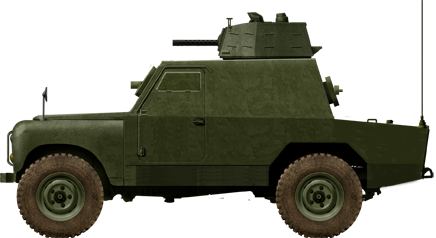
British RUC Mark I in 1966.
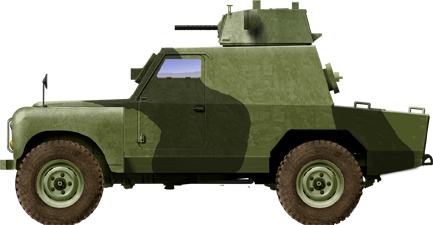
Mark I evaluated by the british Army
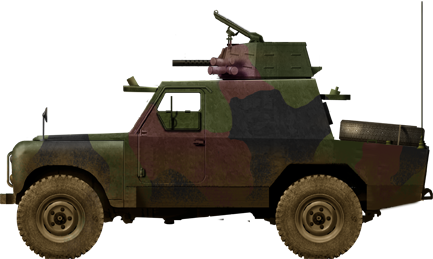
Shorland Mark II used by Trinidad
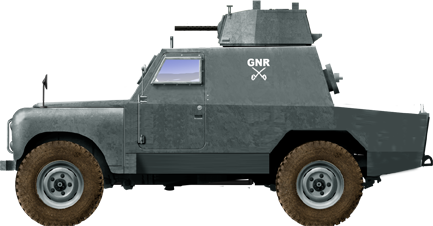
Portuguese Nat. Guard Mark II
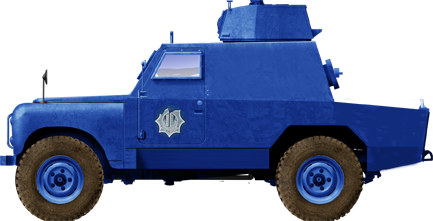
Netherlands Dutch Police
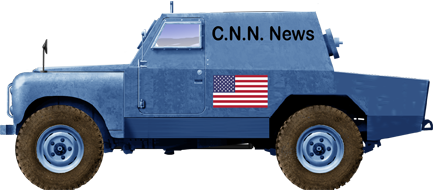
Shortland Mark II of the CNN press in Bosnia
Next: Mark III, IV, V and sub-variants.
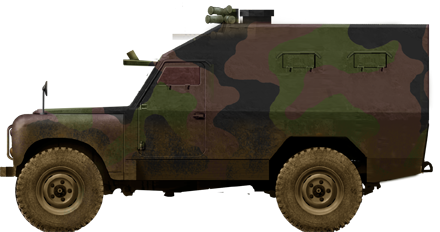
S55 Shorland APC




Mark 5 APC


Cold War Tanks


































Cold war tanks posters

Cold War Main Battle Tanks

Cold War Soviet Army
